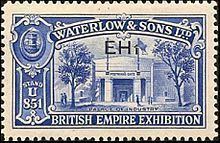Industry Secure printing Headquarters UK | Defunct 2009 Founded 1810 Ceased operations 2009 | |
 | ||
Former type Private Limited Company Fate Acquired (1961)Dissolved (2009) Products BanknotesPostage stampsStock and bond certificates | ||
Waterlow and Sons Limited was a major worldwide engraver of currency, postage stamps, stocks and bond certificates based in London, Watford and Dunstable in England. The company was founded as a family business in 1810. It was acquired in 1961 by De La Rue.
Contents
Early history
Waterlow and Sons originated from the business of James Waterlow, who began producing lithographic copies of legal documents at Birchin Lane in London in 1810. The company gradually grew; it began printing stamps in 1852, and Waterlow' sons Alfred, Walter, Sydney and Albert joined the business. James Waterlow died in 1876, and the company became a limited-liability company. In 1877, due to a family dispute, the company split, and Alfred and his sons formed Waterlow Bros. & Layton. The two companies later reunited in 1920.
Portuguese banknote crisis
Waterlow's was involved in the Portuguese Bank Note Crisis of 1925. The Banco de Portugal sued Waterlow & Sons in the High Court in London because of counterfeiting. In one of the most complex trials in legal history, the case was finally settled in favour of the Bank in 1932.
De La Rue ownership
Waterlow's was acquired by Purnell and Sons in 1961, but Purnell sold Waterlow's segment that printed banknotes, postage stamps, traveler's checks, and bonds to De La Rue soon after.
In 2003 De La Rue acquired the banknote printing operations of the Bank of England, 75 years after Waterlow's had lost the business.
Waterlow and Sons Ltd was dissolved in January 2009.
